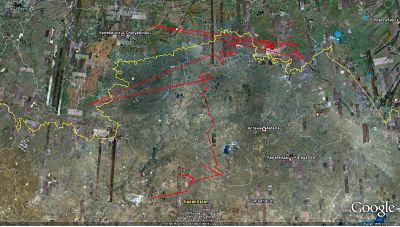The story up to 2010:
Three transmitters fitted to pallid harriers in Kazakhstan in previous years were still transmitting in spring 2009. Two birds seem to have bred in central Kazakhstan and one spent the breeding season in western Kazakhstan. We lost the signal of one of these birds during its post-reproductive prospecting phase in Russia, but the other two individuals initiated their autumn migration normally. Unfortunately, one of these disappeared during its southward migration, when it crossed Iraq.
Movements in 2011:
15/02/2011: The pallid harrier has returned to eastern Syria in the Euphates river basin where he seem to be most at home this winter. His recent excursion into the arid land around the river haven't amounted to much. At the moment he stays in the fertile land close to the ruins of Mari.
25/01/2011: In recent weeks the pallid harrier has continued to stay close to the fertile land around the river but has moved south river into Iraq. There have been one or two excursions into the arid land surrounding the river and one large movement of nearly 400km back into Syria.
05/01/2011: The Pallid Harrier continues to winter in Syria however he has moved upstream in a south-eastern direction. He remains close to the river and surrounding fertile land.
Story during 2010:
The last individual, whose tag is still transmitting, reached its wintering grounds in eastern Africa (Ethiopia), and spent the whole winter there in a relatively constricted area, making no major movements during four months. the land the Pallid harrier remained in looked on the satellite images to be very dry and baron, hardly a place with lots of voles!
06/12/2010: The Pallid harrier remains in the same location as of 1 month ago. The southerly migration seem to have halted at the moment however it is hard to predict if this pallid harrier will continue on or just stay the same area.
23/11/2010: On the it was noted that the Pallid harrier had stopped in Syria and there was very little movements, these are the movements from the last 10 days. Travelling no more than 20km at a time in a relatively restricted area this is not behavior that is expected during the migration.
05/11/2010: The Pallid harrier started it's migration by travelling down through Armenia, Turkey and into Iraq. This map shows movements of th epast 10 days, roughly calculated he is travelling 115km a day. We expected the movements south to continue however there has been an unexpected turn in the direction of migration.
23/07/2010: The recent movements of the past 10 days are thought to be the post breeding dispersal. It is likely that the pallid harrier will now stop for a couple of weeks to have a break before pushing on with the southerly migration! The migration south has started for the pallid harrier, currently in Armenia. He will be hoping to finish his migration somewhere along the Sahel belt.
25/06/2010: The bird has finally settled near Osmk, southwestern Siberia, Russia with recent flightlines showing lots of activity around a nest suggesting probable breeding. Pallid harriers usually start their autumn migration in late August however it is believed that before this journey they move away from the nest area, often quite far.
27/04/2010: In early April this bird began its northward migration, and in the two weeks since starting its migration it has crossed the Red Sea and Saudi Arabia, passed though Iraq and Iran and crossed the Caspian Sea. This bird entered south-western Kazakhstan in mid April, where it carried out it's pre-breeding prospecting phase (as observed in previous springs for other tracked pallid harriers). The aim of this phase is to locate and select suitable steppe habitats for breeding, characterized by high vole abundance.









